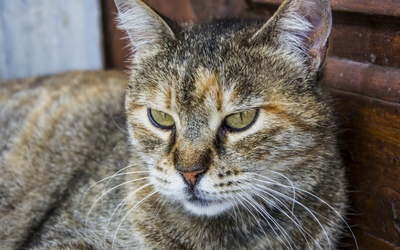
Whiskers! Some of us may have heard that cats use their whiskers to measure space – if the whiskers fit, so does your cat – but is this really true?! In short, yes!
Did you know that cats don’t just have whiskers on either side of their nose? They also have whiskers on their upper lip, above their eyes (eyebrow), on their jaw, and believe it or not, on the backs of their front legs!
Cat whiskers are more than just “hairs” that tickle our faces when we snuggle and kiss our furry friends; whiskers actually send information about your cat’s surroundings to her nervous system. While your cat’s whiskers don’t actually “feel” anything, they do sense changes in air flow or when an object brushes up against them. The whiskers vibrate, which sends signals to the nervous system and brain. By sensing these subtle changes, cat whiskers transmit information about the size, shape, and speed of nearby objects. This helps them navigate their environment – especially at night!
Think of cat’s whiskers as their “radar” system. While cats have a great sense of smell, their vision is not the greatest, especially when looking at objects close by. The whiskers are constantly sending signals to the brain and help your cat to “see” objects. As your cat approaches an object (for example, her food dish), her movement causes the air to move. These stirred up air currents bounce off the food dish and other objects in the room and back to your cat’s whiskers – like radar. This allows your cat to sense where her food dish is and allows her to avoid walking into walls or other objects!
Whiskers really do help your cat from getting stuck in a tight place! As she approaches a narrow opening, the whiskers help her figure out if she’ll fit through, because whiskers roughly correspond to the width of her body.
Those whiskers on the backs of your cat’s front legs help when your cat is climbing, jumping on or off narrow ledges, and help to sense when she quickly needs to move out of harm’s way.
Have you ever noticed changes in the way your cat “holds” her whiskers? Whiskers are a cat’s “mood ring” – you can tell a lot about how your cat is feeling, or what she is doing, by the way she holds her whiskers:
- resting/content – her whiskers are still
- scared – her whiskers are bunched up and lay flat along her face
- startled/excited – her whiskers are directed completely forward (towards the threat)
- hunting/playing mode – her whiskers are pointing forward (towards the toy or prey she is trying to catch)
Never trim, pluck, or pull your cat’s whiskers. Not only will plucking them hurt your cat, but you will be reducing your cat’s ability to gather information about her surroundings, which can cause confusion, disorientation, and fear. It is completely normal, however, for cats to shed their whiskers – they will, of course, grow back on their own!

